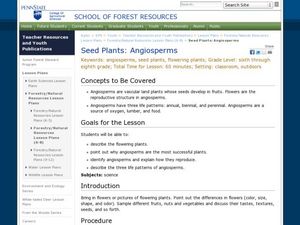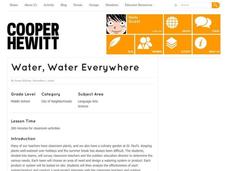Curated OER
Investigation Xylem
Students investigate how water travels up the stem of vascular plants by using food coloring to stain the xylem of a number of different plants. They know the function of leaves, stems, and root at the end of the experiment.
Alabama Learning Exchange
What Kind of Plant is it?
Students evaluate the differences between vascular and nonvascular plants and practice classifying the plants into categories. They demonstrate using drawing software to create two slides showing vascular plants and nonvascular plants.
Curated OER
Harvesting Energy from Food: How do Plants Help Humans?
Beginning botanists view slides of plant vascular tissue. They watch Magic School Bus Gets Planted, which you can find online, and then write a summary of what they have learned about plants. This lesson could be used with upper...
Curated OER
Seed Plants: Angiosperms
Students describe flowering plants and see why angiosperms are the most successful plants. In this angiosperms lesson students identify angiosperms and explain how they reproduce.
Curated OER
Reviving Celery
The classic in-class demonstration using celery dipped into water with food coloring is the highlight of this biology lesson plan. Young scientists discover that organisms are made up cells and have distinguishing characteristics. After...
Curated OER
Plant Life
Seventh graders examine different categories of plant life and their roles as producers of food and oxygen for other organisms. They study the evolution of plants from simple organisms to very complex ones. They look at the different...
Curated OER
Water, Water Everywhere
Students devise a system for watering classroom plants during school year and summer breaks. In this watering system lesson, students work in teams to investigate water needs of plants and develop systems that will keep the plants...
Curated OER
Plants
Student identify the characteristics of plants. Through hands-on demonstration, they create a model of plant parts. Students differentiate between the major divisions of the plant kingdom with a particular emphasis on the vascular and...
Curated OER
Investigation 7 - Plants In Soil
Fourth graders explain how the components of soil effect plant growth. They brainstorm different kinds of materials that plants could use for structural support. They design an experiment to show that plants can grow without soil.
Science 4 Inquiry
Plant Structures Lab Stations
In China, hibiscus is known as the shoe flower because it is used to polish shoes, while in Hawaii, it is honored as the state flower. Young scientists learn about the structure and function of flowers. They dissect hibiscus flowers,...
Curated OER
Plant Classfications
Seventh graders observe and discuss as a class the different types of vascular plants. They examine the different parts of the plant and some of the processes occurring in plants with activities accompanying.
Curated OER
Plant Pipes
Students work together to discover the path water follows in plants. They create multicolored flowers. They label each part of the plant and note their function.
Curated OER
It's Challenging Being Green!
Students influence the plant life cycle as they take care of plants.In this caring for plants lesson, students understand the parts of the plant and their functions in keeping it alive. Students participate in experiments with plants and...
Curated OER
Invertebrates
Students identify the characteristics common to all animals. In groups, they compare the characteristics between the animals and how they are divided. To end the lesson, they compare the eight phyla of invertebrates and review the...
Curated OER
Monocots vs. Dicots
Students examine the differences in nonvascular and vascular plants. They compare the differences between gymnosperm and angiosperms. Students compare the differences between moocots and dicots. They view a powerpoint presentation on...
Curated OER
Plant Roots
Students discover the purpose of plant roots and how they move water through a vascular system. They conduct an experiment using colored water to observe the movement of water through the roots and stem of a plant in a controlled...
Curated OER
Air Pollution
Students seek solutions to environmental problems. They discover how to conserve and protect natural resources. They examine the role of acid rain on plants and discover how to filter pollutants.
Curated OER
The Bean Growth Experiment
Fifth graders use modern technologies which allow them to gain a new, dynamic, and intersting understanding of themselves, their community, and the world. They focus on environmental education and the effect of the environment on plant...
Curated OER
Seed Plants: Gymnosperms
Students identify what makes up a seed. In this gymnosperms lesson students identify conifers and explain how they reproduce and what the importance of gymnosperms are.
Curated OER
Investigating Monocots and Dicots
Students know about monocotyledons and dicotyledons. They explore the differences between the seed structure of the two by examining bean and corn seeds. They sprout seed to observe the differences in both of their growths.
Curated OER
One, Two, Three. TMV
Learners, in groups, design their own experiments to determine how the mode of application of the virus extract affects the various plants that students have grown from seed.
Curated OER
Marine & Aquatic Habitats Activities - Terrestrial Forests vs. Kelp Forests
Students discuss concept and specificity of habitats, both marine and terrestrial, list similarities and differences in the habitats of a kelp forest and a terrestrial forest, compare types of organisms that occupy corresponding types of...
Curated OER
Tree Search
Fifth graders plan and conduct investigations to identify and record tree species. They complete Forest Plotter and write about tree species found and draw pictures of them.
Curated OER
Ecoregions of Texas
Young scholars map the ecoregions in Texas and illustrate the vegetation native to the region. They will use their maps to investigate why prehistoric hunter-gatherers might have decided to live in one area over another, such as the...
Other popular searches
- Non Vascular Plants
- Nonvascular Vascular Plants
- Non Vascular Plants
- Seedless Vascular Plants
- Vascular Plants Venn Diagram
- Vascular Plants Lesson
- Non Vascular Vascular Plants
- Vascular Plants Lesson Unit

























